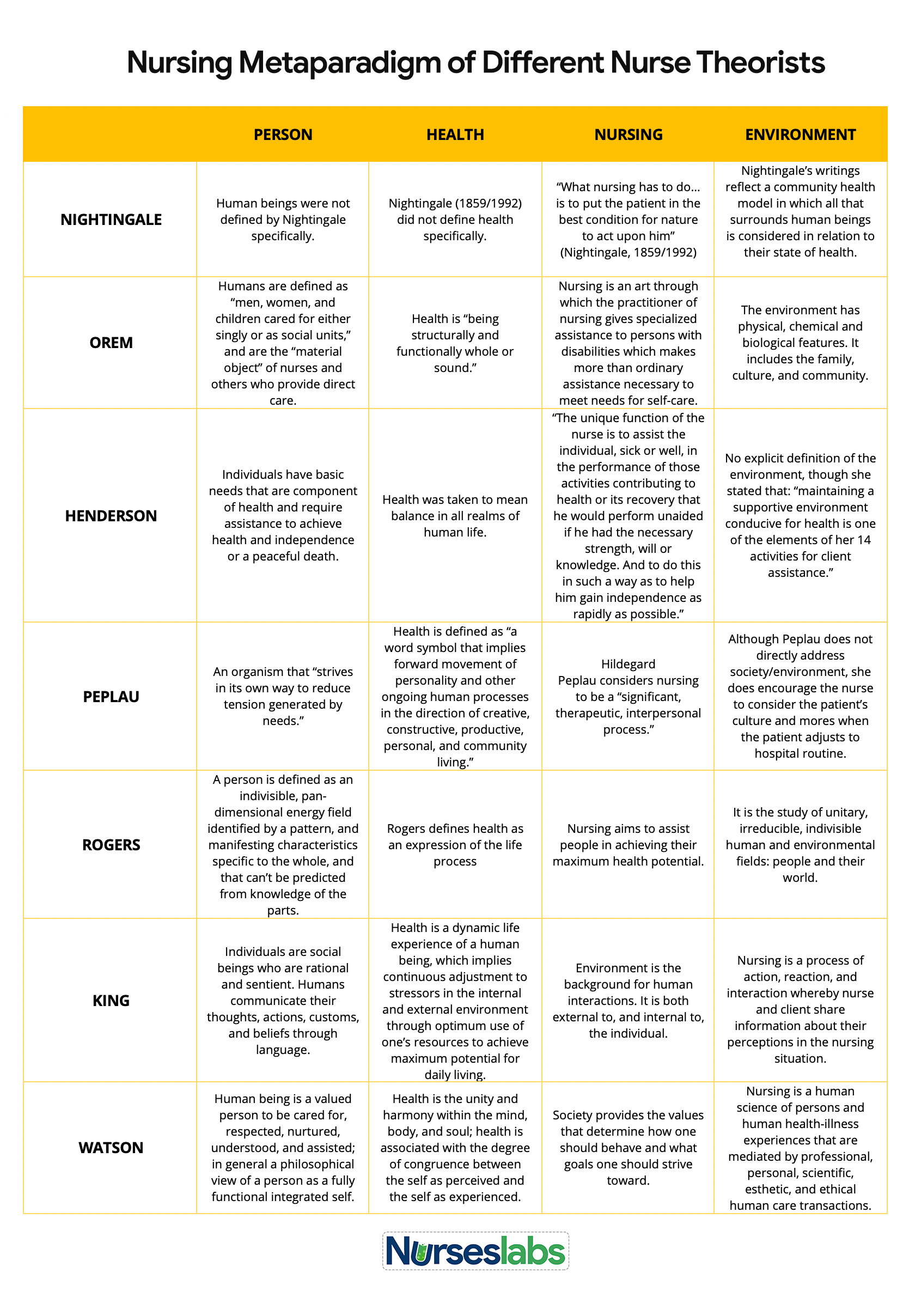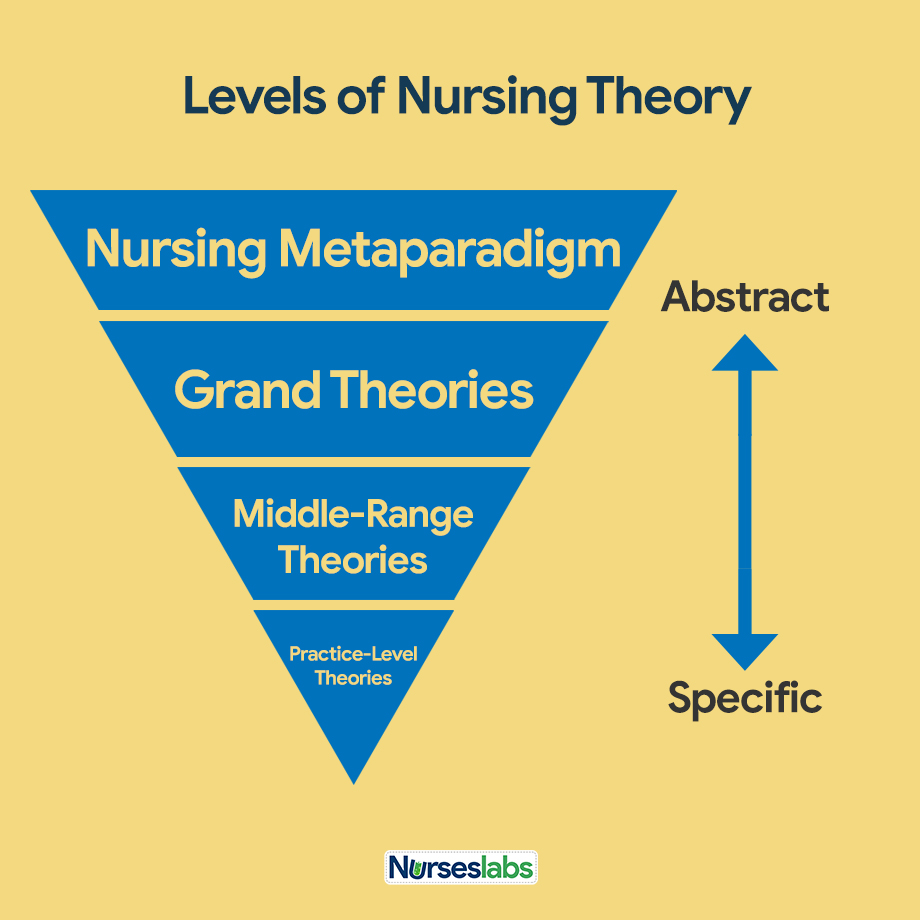nursing theories
Defining Terms
The development of nursing theory demands an understanding of selected terminologies, definitions, and assumptions.
- Philosophy. These are beliefs and values that define a way of thinking and are generally known and understood by a group or discipline.
- Theory. A belief, policy, or procedure proposed or followed as the basis of action. It refers to a logical group of general propositions used as principles of explanation. Theories are also used to describe, predict, or control phenomena.
- Concept. Concepts are often called the building blocks of theories. They are primarily the vehicles of thought that involve images.
- Models. Models are representations of the interaction among and between the concepts showing patterns. They present an overview of the theory’s thinking and may demonstrate how theory can be introduced into practice.
- Conceptual framework. A conceptual framework is a group of related ideas, statements, or concepts. It is often used interchangeably with the conceptual model and with grand theories.
- Proposition. Propositions are statements that describe the relationship between the concepts.
- Domain. The domain is the perspective or territory of a profession or discipline.
- Process. Processes are organized steps, changes, or functions intended to bring about the desired result.
- Paradigm. A paradigm refers to a pattern of shared understanding and assumptions about reality and the world, worldview, or widely accepted value system.
- Metaparadigm. A metaparadigm is the most general statement of discipline and functions as a framework in which the more restricted structures of conceptual models develop. Much of the theoretical work in nursing focused on articulating relationships among four major concepts: person, environment, health, and nursing.
History of Nursing Theories
The first nursing theories appeared in the late 1800s when a strong emphasis was placed on nursing education.
- In 1860, Florence Nightingale defined nursing in her “Environmental Theory” as “the act of utilizing the patient’s environment to assist him in his recovery.”
- In the 1950s, there is a consensus among nursing scholars that nursing needed to validate itself through the production of its own scientifically tested body of knowledge.
- In 1952, Hildegard Peplau introduced her Theory of Interpersonal Relations that emphasizes the nurse-client relationship as the foundation of nursing practice.
- In 1955, Virginia Henderson conceptualized the nurse’s role as assisting sick or healthy individuals to gain independence in meeting 14 fundamental needs. Thus her Nursing Need Theory was developed.
- In 1960, Faye Abdellah published her work “Typology of 21 Nursing Problems,” which shifted the focus of nursing from a disease-centered approach to a patient-centered approach.
- In 1962, Ida Jean Orlando emphasized the reciprocal relationship between patient and nurse and viewed nursing’s professional function as finding out and meeting the patient’s immediate need for help.
- In 1968, Dorothy Johnson pioneered the Behavioral System Model and upheld the fostering of efficient and effective behavioral functioning in the patient to prevent illness.
- In 1970, Martha Rogers viewed nursing as both a science and an art as it provides a way to view the unitary human being, who is integral with the universe.
- In 1971, Dorothea Orem stated in her theory that nursing care is required if the client is unable to fulfill biological, psychological, developmental, or social needs.
- In 1971, Imogene King‘s Theory of Goal attainment stated that the nurse is considered part of the patient’s environment and the nurse-patient relationship is for meeting goals towards good health.
- In 1972, Betty Neuman, in her theory, states that many needs exist, and each may disrupt client balance or stability. Stress reduction is the goal of the system model of nursing practice.
- In 1979, Sr. Callista Roy viewed the individual as a set of interrelated systems that maintain the balance between these various stimuli.
- In 1979, Jean Watson developed the philosophy of caring, highlighted humanistic aspects of nursing as they intertwine with scientific knowledge and nursing practice.
The Nursing Metaparadigm
Four major concepts are frequently interrelated and fundamental to nursing theory: person, environment, health, and nursing. These four are collectively referred to as metaparadigm for nursing.

Person
Person (also referred to as Client or Human Beings) is the recipient of nursing care and may include individuals, patients, groups, families, and communities.
Environment
Environment (or situation) is defined as the internal and external surroundings that affect the client. It includes all positive or negative conditions that affect the patient, the physical environment, such as families, friends, and significant others, and the setting for where they go for their healthcare.
Health
Health is defined as the degree of wellness or well-being that the client experiences. It may have different meanings for each patient, the clinical setting, and the health care provider.
Nursing
The nurse’s attributes, characteristics, and actions provide care on behalf of or in conjunction with the client. There are numerous definitions of nursing, though nursing scholars may have difficulty agreeing on its exact definition. The ultimate goal of nursing theories is to improve patient care.
You’ll find that these four concepts are used frequently and defined differently throughout different nursing theories. Each nurse theorist’s definition varies by their orientation, nursing experience, and different factors that affect the theorist’s nursing view. The person is the main focus, but how each theorist defines the nursing metaparadigm gives a unique take specific to a particular theory. To give you an example, below are the different definitions of various theorists on the nursing metaparadigm:
Components of Nursing Theories
For a theory to be a theory, it has to contain concepts, definitions, relational statements, and assumptions that explain a phenomenon. It should also explain how these components relate to each other.
Phenomenon
A term given to describe an idea or response about an event, a situation, a process, a group of events, or a group of situations. Phenomena may be temporary or permanent. Nursing theories focus on the phenomena of nursing.
Concepts
Interrelated concepts define a theory. Concepts are used to help describe or label a phenomenon. They are words or phrases that identify, define, and establish structure and boundaries for ideas generated about a particular phenomenon. Concepts may be abstract or concrete.
- Abstract Concepts. Defined as mentally constructed independently of a specific time or place.
- Concrete Concepts. Are directly experienced and related to a particular time or place.
Definitions
Definitions are used to convey the general meaning of the concepts of the theory. Definitions can be theoretical or operational.
- Theoretical Definitions. Define a particular concept based on the theorist’s perspective.
- Operational Definitions. States how concepts are measured.
Relational Statements
Relational statements define the relationships between two or more concepts. They are the chains that link concepts to one another.
Assumptions
Assumptions are accepted as truths and are based on values and beliefs. These statements explain the nature of concepts, definitions, purpose, relationships, and structure of a theory.
Why are Nursing Theories Important?
Nursing theories are the basis of nursing practice today. In many cases, nursing theory guides knowledge development and directs education, research, and practice. Historically, nursing was not recognized as an academic discipline or as a profession we view today. Before nursing theories were developed, nursing was considered to be a task-oriented occupation. The training and function of nurses were under the direction and control of the medical profession. Let’s take a look at the importance of nursing theory and its significance to nursing practice:
- Nursing theories help recognize what should set the foundation of practice by explicitly describing nursing.
- By defining nursing, a nursing theory also helps nurses understand their purpose and role in the healthcare setting.
- Theories serve as a rationale or scientific reasons for nursing interventions and give nurses the knowledge base necessary for acting and responding appropriately in nursing care situations.
- Nursing theories provide the foundations of nursing practice, generate further knowledge, and indicate which direction nursing should develop in the future (Brown, 1964).
- By providing nurses a sense of identity, nursing theory can help patients, managers, and other healthcare professionals to acknowledge and understand the unique contribution that nurses make to the healthcare service (Draper, 1990).
- Nursing theories prepare the nurses to reflect on the assumptions and question the nursing values, thus further defining nursing and increasing the knowledge base.
- Nursing theories aim to define, predict, and demonstrate nursing phenomenon (Chinn and Jacobs, 1978).
- It can be regarded as an attempt by the nursing profession to maintain and preserve its professional limits and boundaries.
- Nursing theories can help guide research and informing evidence-based practice.
- Provide a common language and terminology for nurses to use in communication and practice.
- Serves as a basis for the development of nursing education and training programs.
- In many cases, nursing theories guide knowledge development and directs education, research, and practice, although each influences the others. (Fitzpatrick and Whall, 2005).
Purposes of Nursing Theories
The primary purpose of theory in nursing is to improve practice by positively influencing the health and quality of life of patients. Nursing theories are essential for the development and advancement of the nursing profession. Nursing theories are also developed to define and describe nursing care, guide nursing practice, and provide a basis for clinical decision-making. In the past, the accomplishments of nursing led to the recognition of nursing in an academic discipline, research, and profession.
In Academic Discipline
Much of the earlier nursing programs identified the major concepts in one or two nursing models, organized the concepts, and build an entire nursing curriculum around the created framework. These models’ unique language was typically introduced into program objectives, course objectives, course descriptions, and clinical performance criteria. The purpose was to explain the fundamental implications of the profession and enhance the profession’s status.
In Research
The development of theory is fundamental to the research process, where it is necessary to use theory as a framework to provide perspective and guidance to the research study. Theory can also be used to guide the research process by creating and testing phenomena of interest. To improve the nursing profession’s ability to meet societal duties and responsibilities, there needs to be a continuous reciprocal and cyclical connection with theory, practice, and research. This will help connect the perceived “gap” between theory and practice and promote the theory-guided practice.
In the Profession
Clinical practice generates research questions and knowledge for theory. In a clinical setting, its primary contribution has been the facilitation of reflecting, questioning, and thinking about what nurses do. Because nurses and nursing practice are often subordinate to powerful institutional forces and traditions, introducing any framework that encourages nurses to reflect on, question, and think about what they do provide an invaluable service.
Classification of Nursing Theories
There are different ways to categorize nursing theories. They are classified depending on their function, levels of abstraction, or goal orientation.
By Abstraction
There are three major categories when classifying nursing theories based on their level of abstraction: grand theory, middle-range theory, and practice-level theory.
Grand Nursing Theories
- Grand theories are abstract, broad in scope, and complex, therefore requiring further research for clarification.
- Grand nursing theories do not guide specific nursing interventions but rather provide a general framework and nursing ideas.
- Grand nursing theorists develop their works based on their own experiences and their time, explaining why there is so much variation among theories.
- Address the nursing metaparadigm components of person, nursing, health, and environment.
Middle-Range Nursing Theories
- More limited in scope (compared to grand theories) and present concepts and propositions at a lower level of abstraction. They address a specific phenomenon in nursing.
- Due to the difficulty of testing grand theories, nursing scholars proposed using this level of theory.
- Most middle-range theories are based on a grand theorist’s works, but they can be conceived from research, nursing practice, or the theories of other disciplines.
Practice-Level Nursing Theories
- Practice nursing theories are situation-specific theories that are narrow in scope and focuses on a specific patient population at a specific time.
- Practice-level nursing theories provide frameworks for nursing interventions and suggest outcomes or the effect of nursing practice.
- Theories developed at this level have a more direct effect on nursing practice than more abstract theories.
- These theories are interrelated with concepts from middle-range theories or grand theories.
By Goal Orientation
Theories can also be classified based on their goals. They can be descriptive or prescriptive.
Descriptive Theories
- Descriptive theories are the first level of theory development. They describe the phenomena and identify its properties and components in which it occurs.
- Descriptive theories are not action-oriented or attempt to produce or change a situation.
- There are two types of descriptive theories: factor-isolating theory and explanatory theory.
Factor-Isolating Theory
- Also known as category-formulating or labeling theory.


Comments
Post a Comment